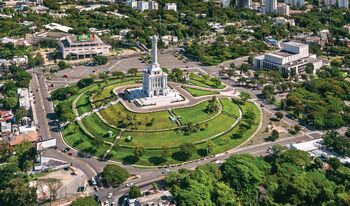
Santiago, officially Santiago de los Caballeros is the second largest city in the Dominican Republic, and the capital of the Santiago Province.
Santiago
Santiago de los Caballeros
Country
Region
Area
524.01 km2 (202.32 sq mi)
Population (2015)
1,173,015
Elevation
175 m (574 ft.)
Distance to:
Puerto Plata:
60 km (37 mi.)
Santo Domingo:
155 km (96 mi.)
Etymology
When, in 1515, by order of Governor Fray Nicolás de Ovando, the primitive settlement was transferred from the banks of the Yaque del Norte river to the Solar de Jacagua, the Spaniards who had called him to the town of Santiago, in memory of the Galician city Santiago de Compostela, they added de Los Caballeros (of the Knights), because their first settlers were 30 knights of the Order of Santiago el Mayor.
History
In 1495, Christopher Columbus founded, during his second trip, the fort of Santiago, on the east bank of the Yaque del Norte River . In 1506, the villa that forms around it is moved to the banks of the Jacagua River . In 1562, Santiago is destroyed by an earthquake. Survivors settle in the land adjacent to the Yaque del Norte River, the city’s current location. When granted in 1508 the Royal Prize of Arms Concession to the Villa of Santiago in Hispaniola , the heraldic figure that was included in his shield was the scallop . The Royal Certificate , signed by King Fernando the Catholic as administrator of the kingdoms of his daughter Juana I of Castile .
The municipality has witnessed important historical events including the Battle of March 30 (1844) or the Battle of Santiago , with which the Dominicans consolidate their independence from the neighboring Republic of Haiti , and took place in the current Park Imbert of this city.
Santiago was an important strategic city in the War of the Dominican Independence in 1844 [ 4 ] and was capital of the Dominican Republic during the War of the Restoration (1863-1865)
The domination of the French by the Peace of Basel (which ceded the Spanish part of the island to France in 1795) left its mark on Santiago. From that deed, the municipality began planning a modern urban area. European neoclassicism is represented in the Consistorial Palace, built between 1892 and 1895, by the Belgian architect Luis Bogaert. The Victorian era was the zenith of architecture in the city. Numerous residences were built in the elegant European neoclassical style that are what make up the historic center of Santiago. [ 5 ]
Geography
It is the second largest municipality in the Dominican Republic, and seat of the Santiago province and main metropolitan center of the northern region or Cibao. It is located in the north-central region of the country known as the Cibao Valley, about 155 km northwest of Santo Domingo and an average altitude of 178 meters above sea level. It has a total area of 612 km2.
It has five municipal districts: Santiago, Pedro Garcia, La Canela, San Francisco de Jacagua, and Hato del Yaque.
Climate
The average temperature varies little in the city, due to tropical trade winds that help mitigate heat and humidity throughout the year. The months December and January are the coldest and July and August are the hottest. Santiago and the rest of the country are in the Caribbean and have a tropical climate , which, together with the city’s altitude, 183 meters above sea level, makes cloudy conditions persist for much of the year. The city and the country also form apart from the hurricane zone, however, Santiago is more protected than in other parts of the country due to its location in the Cibao Valley.
The extreme temperatures (records) are: 41.0 ° C (105.8 ° F), maximum temperature recorded on September 13, 1960; [ 6 ] and 11.2 ° C (52.2 ° F), minimum temperature recorded on January 31, 1987.
Economy
The municipality of Santiago depends heavily on fertile land and a predominantly provider service economy. This makes Santiago an important economic and financial center of the Dominican Republic . The services sector has grown a lot in recent years, which is ideal for further expansion. Santiago is the second largest municipality in the Dominican Republic by GDP , importance and population after Santo Domingo and at the same time produces the highest percentage of telecommunications GDP, such as; Mobile phones , cable service, internet service and other services that are important for the economy of Cibao . Tourism also represents an important portion of the city’s economy due to its historical evolution and its monumental architecture.
The economy of Santiago is sustained mainly by the commercialization and industrialization of agricultural products and finished goods, production of goods in free zones, and by commerce. The headquarters and branches of the main stores, supermarkets, restaurants and financial institutions of the country are established in the city. The city has several shopping centers and multinational companies.
The Mercado del Sol Model Market is a shopping center where there are varied handicraft shops and hand-made native items.
Like Santo Domingo, Santiago has recently experienced a time of rapid growth and development. It has become a city of great importance for the nation and the development of the Cibao region. Santiago, like any other fast-growing city, faces numerous problems including irregular electricity and drinking water . The population of Santiago de los Caballeros is approximately 1,087,000 inhabitants. The fastest growing neighborhood in the city of Santiago is Cienfuegos and the upper middle class sector La Trinitaria.
Art and Culture
Architecture
The Monument to the Heroes of the Restoration built in 1944, has become the emblem of the city Santiago Apostle Cathedral: It was built in 1895 by Onofre de Lora, a native architect of the city. Considered the eclectic monument par excellence in the city, it preserves one of the only two copies that exist in the world of the famous sculpture “La Piedad”, by Michelangelo. Oriented from East to West, and occupying the space reserved for the parish church since the third foundation of the city in 1562. It consists of three naves, of which the largest, with a barrel vault, is crowned in the apse by a dome, in whose scallops the painting of the Four Apostles can be observed, works of the Italian artist Hugo
Patiño Brothers Bridge: it is both the largest and oldest bridge in the city that connects the north and south of the city. Its construction was initiated by Rafael Leónidas Trujillo and was inaugurated in 1962, one year after his death. The bridge is named after the five brothers who died in an effort to end the dictatorship of Rafael Leónidas Trujillo in the Dominican Republic in the mid-twentieth century. The Antitrujillista legacy of the Patiño family did not start with the brothers, but with his father who was killed in 1931 in the first insurrection against Trujillo.
Monument to the Heroes of the Restoration: it is located on a hill with spectacular views of the entire city of Santiago de los Caballeros, measures 67 meters (220 feet) high and is made entirely of marble . The construction of the monument began in 1944 by order of the then dictator Rafael Leónidas Trujillo Molina, whom they called the Trujillo Peace Monument . Trujillo was killed in 1961, and the monument was renamed Monument to the Heroes of the Restoration , in honor of the War of the Restoration of 1863 whose main episodes happened in Santiago; In it, the Dominican Republic regained its independence from Spain to which it was attached.
Places of Interest
• Centro Español, Inc .: founded on December 5, 1965, it is a social and sports club, created by Spanish emigrants who settled in Cibao at the beginning of the 20th century. • Gurabito Country Club : is a sports, social and cultural society created nonprofit on October 14, 1931. • Dominican-American Cultural Center : It is located at Avenida Sadhalá # 101 in the city of Santiago de los Caballeros. The CCDA is a binational, cultural and educational institution founded on June 23, 1962, directed by a Board of Directors.
Other places of interest are: • Art House • House of Culture • Santiago Culture Center. • Santiago Country Club. • Cibao Stadium . • Great Arena of the Cibao . • Great Theater of the Cibao . • The 37 by the Tables. • Santiago monument .
Museums
In Santiago de los Caballeros there are some interesting museums that show the culture of this city. Some of them are: • Yoryi Morel Folk Museum : This museum is located in the Historic Center of Santiago on Restoration Street. It exhibits the culture of the Santiago carnival, and some interesting garments worn by the carnival piglets are shown, as well as those worn in other provinces. The museum is named after the prominent Dominican painter Yoryi Morel . • Tobacco Museum : it is located in the center of the city. It has different manufacturing methods, as well as the effect of tobacco plantations throughout the city’s history. • San Luis Fortress Historical Museum : it is located in front of the Yaque del Norte River in the southwest of Santiago. Formerly this building served as a municipal prison and is one of the oldest fortresses in the Cibao region. • Museum of the Restoration Heroes : it is located inside the Santiago Monument . Show the photos of the Restoration War 1863-1865 . Battle between the Dominican Republic and the Spanish army.
• Eduardo León Jimenes Cultural Center : located on Avenida 27 de Febrero. It shows the elements of the cultures of the Caribbean and the Dominican Republic, the Dominican natural history, the evolution and culture of the native Indians . In addition, periodically there are art exhibitions of different Dominican and international artists. It consists of three permanent exhibition halls: Signs of Identity , a room with Genesis and trajectory (which every two years exhibits the selected works of the Eduardo León Jimenes Art Contest) and a temporary exhibition hall. In its gardens is located the Caribbean Courtyard, where there are gatherings and projections of events of interest, as well as live presentations. The museum is under the authority of the León Jimenes Foundation (owners of the Dominican National Brewery, as well as the León Jimenes Tobacco Industry) • Museum of Folk Art Tomás Morel : in this place you can admire articles related to folklore and everyday aspects of the life of the home of Santiago from the colonial era until 1960. It contains a collection of piglet masks, representing the Santiago carnival. It is located on Restoration Street. • Santiago Culture Center : it is the place where cultural events and activities related to the fine arts come together . There are exhibitions of paintings, sculptures; theater presentations, ballet, concerts, among others. It also functions as an art teaching center, in its different manifestations. It is also the home of one of the best folk Ballets in the country, The Folkloric Ballet of Santiago. It is located on El Sol street corner Antonio Guzmán.
